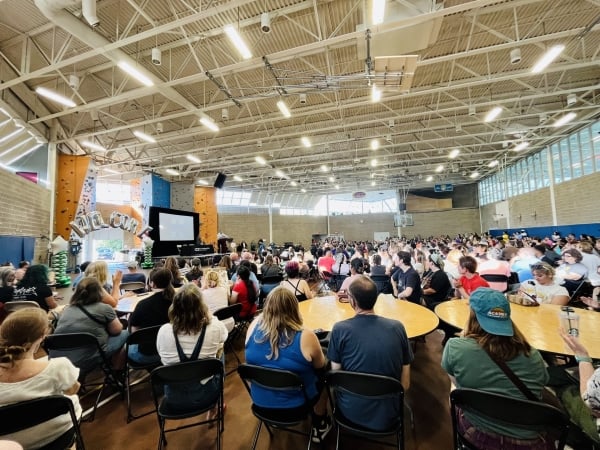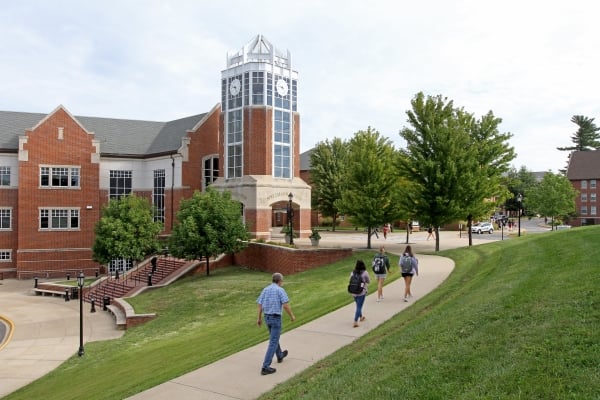Last December, Lindenwood University cut 10 of its 50 sports programs and eliminated nine nonathletic staff positions as part of a budgetary “rebalancing,” as the university called it. In order to get through the fiscal year without additional cuts, the small private college in St. Charles, Mo., needed tuition revenue to hold steady.
Instead it experienced the biggest enrollment disruption since the COVID-19 pandemic.
The rollout of the new Free Application for Federal Student Aid was delayed by months, and when the form debuted it was riddled with errors, setting back student completion rates and undermining colleges’ yield predictions. In Missouri, where the vast majority of Lindenwood students come from, only 41 percent of high school seniors had completed the FAFSA as of June 14—one of the lowest rates in the country, and down 12 percent from last year, according to data from the National College Attainment Network.
Lindenwood’s projected fall enrollment is also down 12 percent year over year, a decline that President John Porter attributes largely to the FAFSA woes. This month the university announced it would cut an additional 10 percent of its operating budget by the fall, starting with layoffs for another 12 staff and two faculty members.
“We would not have cut to the degree that we did had it not been for what we’re seeing with FAFSA,” Porter said. “I don’t want to put all the blame there, but it certainly caused us to take a step back and reassess our costs.”
Small independent colleges have been closing at an accelerated pace, and many of those teetering on the edge are restructuring, slashing budgets left and right; this semester has been particularly rough for program cuts. Small institutions are also more reliant on tuition revenue than ever, and the enrollment consequences of the bungled FAFSA launch have pushed some to make more drastic cuts than they otherwise might have.
Justin Monk, director of student and institutional aid policy at the National Association of Independent Colleges and Universities, said the FAFSA crisis was a “force multiplier” that expedited program cuts at small colleges already buckling under a confluence of financial challenges.
“Small colleges and universities are having to stretch their resources thinner than ever … We’ve certainly heard from numerous schools anecdotally that this year has been remarkably challenging,” he said. “[The FAFSA] removed a lot of the margin that schools had to deal with other issues.”
Stalling Progress
The last black swan event for small colleges was the COVID-19 pandemic, which sent enrollments plummeting across higher ed and hit small tuition-dependent colleges especially hard. The institutions that survived had been slowly recovering from the downturn, but this year’s FAFSA holdup has stunted their progress.
At Hampshire College in Amherst, Mass., the FAFSA debacle reversed three years of enrollment and financial growth.
In 2019 the tiny institution of about 700 students faced likely closure and did not admit incoming freshmen for fall 2020. But in a conversation with MassLive in March, President Ed Wingenbach sounded bullish about the college’s path to sustainability, predicting that Hampshire would surpass its goal of 1,000 students in fall 2024.
Then, two weeks ago, the college announced over $1 million in cuts to staff benefits and administrator salaries. In an email to Inside Higher Ed, a Hampshire spokesperson said that due to the FAFSA challenges, enrollment predictions were lower than anticipated earlier in the spring.
“FAFSA delays contributed to our current enrollment numbers for Fall 2024, which are lower than our projected goal, as we have heard directly from applicants and their families,” the spokesperson wrote. “Quantifying exactly what might have been, had FAFSA not been such a mess, is a challenge. Realistically tuition, food, housing and fees comprise a majority of our revenue, and we are working to adjust our expenses from current levels to meet our anticipated revenue in light of these enrollment realities.”

Students and families gather for orientation at Hampshire College in August 2023. The institution was recovering from a steep decline until the FAFSA crisis set it back.
Johanna Alonso for Inside Higher Ed
Other colleges are facing similar setbacks. Last year Lindenwood welcomed 805 freshmen to campus, its largest incoming class in a decade—just three years after enrollment dropped by 20 percent due to the pandemic. This year, Porter predicts, the college won’t see the same upward trajectory.
DJ Menifee, vice president for enrollment, marketing and communications at Bradley University in Peoria, Ill., said his institution made a concerted effort last year to recover from a steep decline in enrollment, from 1,040 students in 2022 to 835 in 2023. So far, however, enrollment predictions for the fall hover at 832.
Menifee said he “feels good” about not falling further given the challenges, but he hopes for better results in the coming years.
“Our expectations shifted while the FAFSA data was coming out,” he said.
Monk said he’s concerned that many small colleges may be more than temporarily waylaid by the FAFSA-instigated enrollment dip this year.
“Enrollment declines aren’t just a one-year problem; those rippled effects follow you for four years” he said. “So there’s quite a bit of worry now, but also certainly for the future.”
Planning for the Worst
For some small private colleges already facing long-term financial shortfalls and mulling strategic pivots, this year’s financial aid fiasco has prompted drastic steps.
Earlier this month the University of Lynchburg announced it would restructure its academic offerings, cutting 12 undergraduate degrees and five graduate programs, in addition to firing 40 staffers. A Lynchburg spokesperson declined to comment for this article, but in a video announcing the cuts, President Alison Morrison-Shetlar said the university was “at a crossroads” and that “the FAFSA crisis,” among other factors, had “a profound impact.”
Despite significant cuts over the past six months, Porter said, Lindenwood is in an “excellent financial position.” But his administration has been seeking for a while now to right the ship; the FAFSA crisis simply exposed some of Lindenwood’s bigger strategic problems and expedited plans to trim fat and increase institutional student aid.
“The FAFSA actually instigated a lot of our thinking on how far we need to go,” he said. “It helped us realize what needed to be done.”
Porter said the university has ramped up recruitment and marketing spending this summer to try to recover as many lost students as possible. Officials have purchased 23 new billboard ads across Missouri, placed local television spots and invested in targeted recruitment of students who applied to Lindenwood but never committed. Porter said deposits are up 23 percent this month compared to last June.
But cutting programs is part of a broader strategy of “planning for the worst-case scenario,” he said.
“We’re not going to wait until August and cross our fingers hoping for the best … If we do hit the worst-case scenario, these measures allow us to operate with margins,” Porter said. “If other universities aren’t planning this way, and are just hoping to squeak by and see what happens, I’d say that’s a bad philosophy.”

